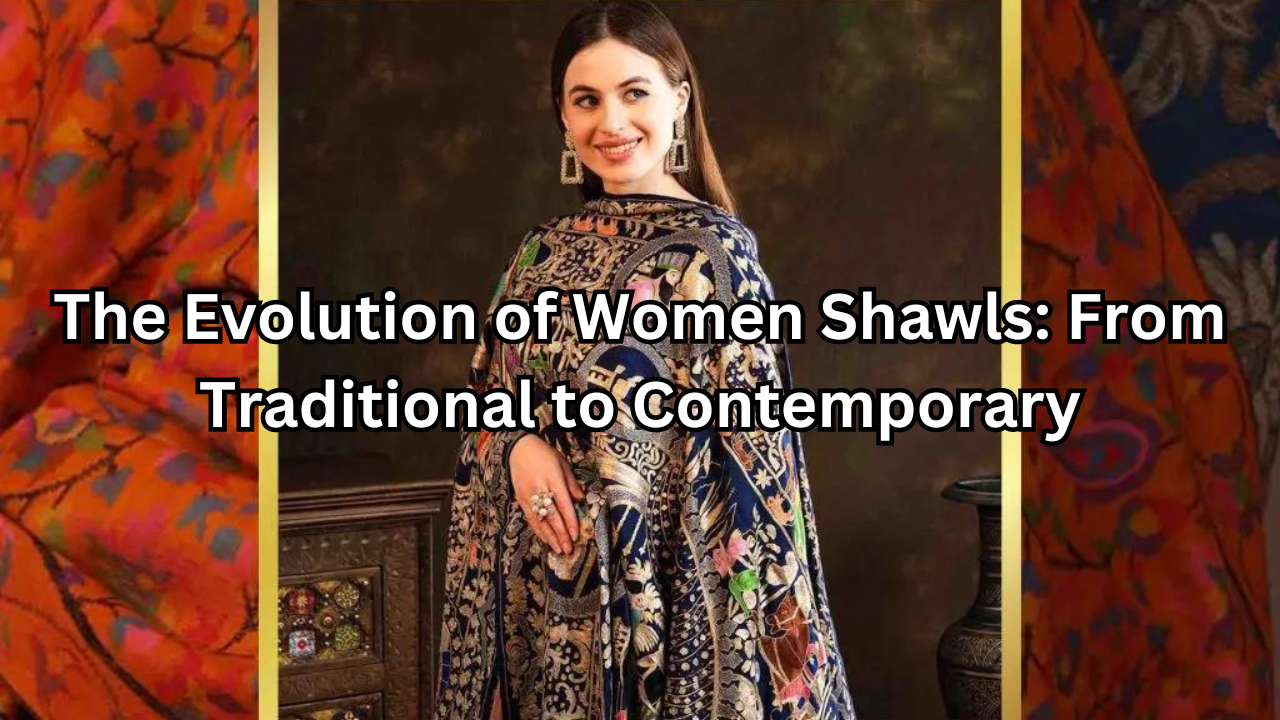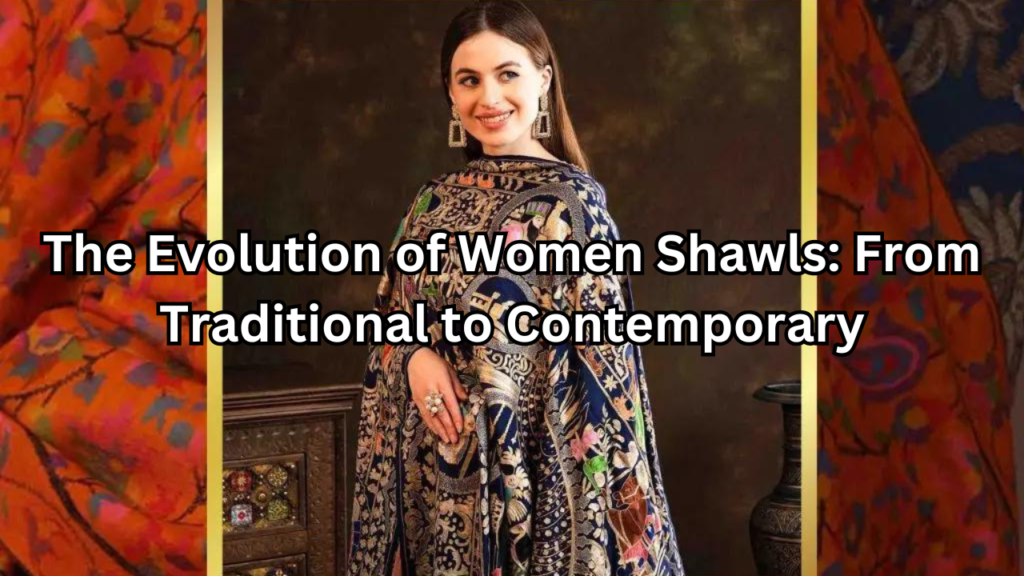

Table of Contents
Introduction
Shawls have long been more than just garments; they are symbols of culture, style, and personal expression. Historically rooted in both necessity and fashion, women’s shawls have evolved from simple, utilitarian pieces to sophisticated, multifunctional accessories.
Definition and Significance of Women Shawls Fashion
A shawl is a versatile piece of clothing, typically worn over the shoulders and around the upper body. Traditionally made from a variety of materials such as wool, silk, or cotton, shawls serve multiple purposes—from providing warmth and comfort to enhancing the aesthetic appeal of an outfit. In many cultures, shawls have also carried significant symbolic meanings, representing social status, tradition, and regional identity.
Overview of the Article’s Scope
This article explores the journey of women shawls from their traditional origins to their contemporary forms. We will trace their historical roots, examining how they were used in different cultures and periods. We will then delve into the changes brought about by social, economic, and fashion trends over the centuries. Finally, we will look at how modern designers and fashion influences have redefined the shawl, transforming it into a chic accessory that continues to captivate and inspire. Through this exploration, we aim to highlight how the shawl has adapted over time while retaining its timeless charm.
Historical Origins of Shawls
Early Use of Women Shawls in Ancient Civilizations
The shawl’s history can be traced back to some of the earliest civilizations, where it served both functional and symbolic purposes. In ancient Mesopotamia, shawls were commonly worn as part of everyday attire. They were typically made from wool or linen and were used to provide warmth and modesty. These early shawls often featured simple, practical designs and were essential for protection against the elements.
Similarly, in ancient Egypt, shawls and similar garments were worn by both men and women. They were often draped over the shoulders and were made from fine linen, reflecting the region’s hot climate. Egyptian shawls sometimes featured intricate beadwork or embroidery, indicating their use in ceremonial or elite contexts. These garments not only served practical purposes but also conveyed social status.
The Role of Shawls in Different Cultures
As civilizations evolved, so did the role and significance of shawls in various cultures. In India, the shawl became a symbol of both cultural identity and social status. The Kashmiri shawl, renowned for its exquisite craftsmanship and luxurious materials, emerged as a highly coveted item. Handwoven with fine pashmina wool, these shawls often featured elaborate patterns and embroidery, reflecting the rich artistic traditions of the region.
In Persian culture, shawls also held significant importance. Persian shawls, known for their intricate designs and high-quality materials, were often used as markers of social status and wealth. These shawls were frequently adorned with elaborate patterns, including floral motifs and geometric designs, demonstrating the advanced weaving techniques and artistry of the time.
Traditional Materials and Techniques Used in Early Shawl-Making
The materials and techniques used in early shawl-making varied widely across cultures but shared common threads of craftsmanship and practicality. In ancient Mesopotamia, wool was the primary material used, reflecting its availability and suitability for the region’s climate. Weaving techniques included simple hand looms and basic patterns, focusing on functionality and durability.
In contrast, Indian shawls were crafted using more refined materials like cashmere and silk. The weaving techniques employed were highly sophisticated, including techniques like jacquard weaving and embroidery. The intricate patterns and vibrant colors were achieved through painstaking handwork, making each shawl a unique piece of art.
Persian shawls, known for their luxurious feel, were often made from fine wool or silk. The weaving techniques involved were complex, with artisans employing detailed patterns and dyes to create stunning visual effects. Techniques such as silk weaving and embroidery were used to enhance the beauty and value of these garments.
In summary, the historical origins of shawls reflect a rich tapestry of cultural traditions, materials, and techniques. From ancient Mesopotamia and Egypt to the sophisticated artistry of Indian and Persian shawls, the evolution of these garments highlights their enduring significance and versatility throughout history.
The Shawl in Traditional Cultures
Indian Women Shawls
The Art of Kashmiri Shawls
Kashmiri shawls are renowned for their exceptional craftsmanship and intricate designs. Originating from the Kashmir region of India, these shawls are often made from fine pashmina wool, which is highly prized for its softness and warmth. Pashmina shawls, known for their luxurious feel, are handwoven with great skill, employing techniques and equipment passed down through generations.
Among the various types of Kashmiri shawls, the pashmina is the most famous for its delicate texture and warmth. The kani shawl, another exquisite type, is created using a traditional technique where small wooden handlooms are used to weave intricate patterns. These shawls often feature detailed motifs inspired by nature, such as flowers, leaves, and paisleys, and are known for their vibrant colors and rich textures.
Cultural and Ceremonial Significance
In India, Kashmiri shawls have long held cultural and ceremonial importance. They are often worn during special occasions such as weddings, festivals, and religious ceremonies. The shawl is not only a symbol of status and elegance but also a traditional gift that signifies respect and honor. The art of creating these shawls is deeply embedded in Kashmiri culture, representing a blend of artistic heritage and skilled craftsmanship.
Middle Eastern Shawls
Variations and Styles
Middle Eastern shawls come in various styles, each with distinct cultural significance. The keffiyeh, a traditional headscarf, is widely recognized for its checkered pattern and is often worn by men in the Arab world. It serves both practical and symbolic purposes, providing protection from the sun and dust while also representing cultural and political identity.
Another notable style is the abaya shawl, commonly worn by women in the Middle East. The abaya is a loose-fitting garment that covers the entire body, often worn over regular clothing. It comes in various designs, from simple and elegant to richly adorned with embroidery and embellishments. The abaya shawl represents modesty and is an important part of traditional dress in many Middle Eastern countries.
Symbolism and Traditional Uses
Middle Eastern shawls are imbued with symbolic meanings and serve various traditional uses. The keffiyeh, for example, symbolizes solidarity and heritage, often associated with national identity and resistance. The abaya shawl represents cultural values of modesty and piety, and its design can vary based on regional and personal preferences.
European Shawls
Historical Evolution
In Europe, the evolution of shawls reflects changing fashion trends and social norms. During the Victorian era, shawls became an essential part of women’s formal attire. Victorian-era shawls were often made from luxurious fabrics like velvet and silk, adorned with lace and intricate embroidery. These shawls were designed to complement formal dresses and were worn for both warmth and style.
Lace shawls, a notable European style, gained popularity in the 19th and early 20th centuries. These delicate garments, often handcrafted with intricate lace patterns, were prized for their elegance and versatility. Lace shawls were typically worn over evening gowns or formal dresses, adding a touch of sophistication and refinement.
Regional Styles and Influences
European shawls exhibit a diverse range of styles influenced by regional traditions and historical events. For example, in Scotland, tartan shawls are a distinctive feature of Highland dress, reflecting clan heritage and identity. In France and Italy, shawls often feature ornate designs and luxurious materials, showcasing the country’s rich history of fashion and textile craftsmanship.
The evolution of European shawls demonstrates a blend of traditional elegance and modern innovation, with styles adapting to changing fashion trends while retaining their historical charm.
The Transition to Modern Women Shawls
Industrial Revolution Impact
Technological Advancements in Textile Production
The Industrial Revolution marked a significant turning point in the production of shawls. The advent of mechanized looms and spinning machines revolutionized textile manufacturing, making the production of shawls more efficient and affordable. Innovations such as the Jacquard loom allowed for the creation of intricate patterns with greater ease, enabling a broader range of designs and textures.
The Introduction of New Materials and Manufacturing Techniques
With technological advancements came the introduction of new materials. Synthetic fibers, such as acrylic and polyester, began to emerge, offering alternatives to traditional natural fibers like wool and silk. These new materials were more durable, less expensive, and easier to care for, leading to a democratization of shawls and an expansion in their use across different social classes. Additionally, advancements in dyeing techniques allowed for a wider range of colors and patterns, further enhancing the versatility and appeal of shawls.
20th Century Innovations
The Influence of Fashion Designers and Trends
The 20th century saw shawls being transformed by influential fashion designers. Coco Chanel, for example, revolutionized women’s fashion by incorporating shawls into her collections. Her use of simple, elegant shawls complemented her designs and emphasized functionality and style. Chanel’s influence helped shift shawls from purely traditional garments to fashionable accessories that could be worn in various settings.
Changing Uses of Shawls in Everyday Fashion versus Formal Wear
Throughout the 20th century, shawls became increasingly versatile. In everyday fashion, they were used as casual layering pieces, often seen in casual outfits or as stylish throws over simple attire. In contrast, for formal occasions, shawls continued to be crafted from luxurious materials and adorned with intricate designs, maintaining their status as elegant accessories for evening wear and special events.
Contemporary Shawl Trends
Modern Fabrics and Materials
Use of Synthetic Fibers, Eco-Friendly Materials
In contemporary fashion, Women shawls have embraced a variety of modern fabrics and materials. Synthetic fibers like polyester and nylon offer durability and affordability, while eco-friendly materials such as organic cotton and recycled fibers appeal to the growing demand for sustainable fashion. These materials not only contribute to the longevity of the shawl but also align with modern environmental concerns.
Innovations in Texture, Pattern, and Color
Modern shawls feature innovative textures, patterns, and colors that reflect current fashion trends. Advances in fabric technology have allowed for the creation of unique textures, such as plush velvet and lightweight mesh. Patterns have evolved from traditional motifs to bold, abstract designs, while colors range from classic neutrals to vibrant, seasonal hues. This diversity in design caters to a wide range of personal styles and fashion preferences.
Fashion and Functionality
The Role of Shawls in Contemporary Fashion
Today, shawls play a multifaceted role in contemporary fashion. They are often used as statement pieces that add a touch of sophistication to any outfit. Shawls are frequently layered over casual wear for an elevated look or draped over formal attire to enhance elegance. Designers continue to experiment with shawl styles, incorporating innovative designs that reflect the latest trends while maintaining timeless appeal.
Practical Uses: From Casual to Formal Settings
Shawls are celebrated for their versatility, functioning in various settings from casual to formal. In everyday life, they can be used as cozy wraps during cooler months or as stylish accessories for a casual day out. In formal settings, shawls remain a classic choice for adding warmth and elegance to evening gowns and formal dresses. This adaptability ensures that shawls remain a staple in both everyday and high-fashion wardrobes.
Cultural Revival and Fusion
Revival of Traditional Techniques in Modern Designs
Modern fashion has seen a resurgence of traditional shawl-making techniques, with designers incorporating age-old methods into contemporary designs. Techniques such as hand-weaving and embroidery are being revived, blending traditional craftsmanship with modern aesthetics. This fusion not only honors cultural heritage but also adds unique, artisanal elements to contemporary shawls.
Cross-Cultural Influences and Hybrid Styles
The globalization of fashion has led to cross-cultural influences, resulting in hybrid shawl styles that combine elements from different traditions. For example, a shawl might feature traditional Indian embroidery alongside modern Western cuts, creating a unique fusion piece. These hybrid styles reflect a broader trend towards inclusivity and diversity in fashion, celebrating cultural intersections and blending various influences into cohesive designs.
Iconic Shawl Designs and Designers
Spotlight on Influential Designers and Brands
Throughout fashion history, several designers and brands have made significant contributions to the evolution of women shawls, shaping their role and impact in the fashion world.
Coco Chanel
- Coco Chanel revolutionized the use of shawls by incorporating them into her elegant and minimalist designs. Her innovative approach to fashion included the use of shawls in casual and formal contexts, blending sophistication with functionality. Chanel’s influence helped shift the perception of shawls from traditional to chic, making them a staple in modern wardrobes.
Missoni
- Known for its vibrant patterns and knitwear, Missoni brought a distinctive approach to shawl design. The brand’s use of colorful zigzag patterns and textured knits transformed shawls into bold fashion statements. Missoni’s designs continue to influence contemporary shawl aesthetics, emphasizing creativity and boldness.
Etro
- Etro, renowned for its luxurious fabrics and intricate patterns, has made a significant impact on shawl design. The brand’s shawls often feature elaborate paisley patterns and high-quality materials, reflecting a blend of traditional craftsmanship and modern elegance. Etro’s shawls are celebrated for their opulence and distinctive style.
Iconic Shawl Designs and Their Impact on Fashion
The Chanel Shawl
- The Chanel shawl, characterized by its understated elegance and versatility, became iconic through its association with Coco Chanel’s designs. Often crafted from fine wool or cashmere, Chanel shawls are known for their simple yet refined aesthetics. Their impact lies in their ability to seamlessly integrate into both everyday wear and high-fashion ensembles.
Missoni’s Zigzag Shawl
- Missoni’s zigzag shawl is an iconic design known for its vibrant colors and distinctive pattern. The use of knit fabrics and bold geometric designs set a new standard for shawls, showcasing how a traditional accessory could be transformed into a statement piece. This design continues to influence contemporary fashion with its dynamic and eye-catching patterns.
The Etro Paisley Shawl
- Etro’s paisley shawls are celebrated for their intricate and luxurious patterns. The paisley motif, often rendered in rich colors and fine materials, has become synonymous with opulent style. Etro’s shawls have impacted fashion by demonstrating how traditional patterns can be reimagined in modern contexts, bridging historical design with contemporary trends.
The Future of Women Shawls
Emerging Trends and Predictions
Integration of Smart Technology
- As technology continues to advance, the integration of smart features into shawls is becoming a possibility. Innovations such as temperature-regulating fabrics and built-in LEDs could offer both functional and aesthetic benefits, merging fashion with technology to create versatile and high-tech accessories.
Sustainable and Ethical Fashion
- The future of shawls is increasingly aligned with sustainability and ethical fashion practices. Designers are focusing on eco-friendly materials such as organic cotton, recycled fibers, and low-impact dyes. The push towards sustainability is not only about material choices but also about ethical production processes, aiming to reduce the environmental footprint of fashion.
The Role of Technology and Sustainability in the Future of Shawls
Technological Innovations
- Future shawls may incorporate advanced textile technologies, such as fabric treatments that enhance durability, resistance to environmental factors, and functionality. Innovations like smart textiles that adapt to changing weather conditions or health-monitoring fabrics could redefine the role of shawls in both fashion and practicality.
Commitment to Sustainability
- The fashion industry’s growing emphasis on sustainability is shaping the future of shawls. Designers are exploring ways to minimize waste, use sustainable materials, and implement ethical production practices. The focus on circular fashion, where garments are designed for longevity and recyclability, will likely influence the design and production of shawls in the coming years.
Cross-Cultural Fusion and Personalization
- As global influences continue to merge, shawl designs are expected to reflect a rich blend of cultural elements. Customization and personalization will also play a significant role, with consumers seeking unique, tailored designs that reflect their individual style and heritage. This trend towards personalized fashion will likely drive innovation in shawl design, creating opportunities for bespoke and hybrid styles.
Conclusion
Summary of Key Points
Women Shawls, the shawl has evolved from a practical garment used for warmth and modesty to a versatile fashion accessory with significant cultural and stylistic importance. From its early use in ancient Mesopotamia and Egypt to its refined role in traditional Indian, Middle Eastern, and European cultures, the shawl has demonstrated remarkable adaptability and significance. The Industrial Revolution introduced technological advancements that expanded shawl production and materials, while the 20th century saw influential designers like Coco Chanel and brands such as Missoni redefine the shawl’s place in fashion.
In contemporary times, modern fabrics and innovative designs have breathed new life into shawls, allowing them to serve both functional and aesthetic purposes. Emerging trends, including technological integration and a focus on sustainability, are poised to shape the future of shawls, ensuring their continued relevance and appeal.
Reflection on the Enduring Appeal and Versatility of Shawls Through Time
The enduring appeal of shawls lies in their unique combination of practicality, elegance, and cultural significance. Their versatility allows them to be adapted for various occasions, from casual everyday wear to formal events, while their rich history and diverse styles reflect a global tapestry of tradition and innovation.
Shawls have transcended time and geography, evolving to meet the changing needs and tastes of fashion while retaining their core essence as symbols of comfort and style. Their ability to merge functionality with artistic expression ensures that shawls will continue to be cherished and celebrated in fashion for generations to come. As we look to the future, the shawl’s adaptability and continued evolution promise to keep it a staple in wardrobes worldwide, blending heritage with modernity in a way that honors its past while embracing the future.





